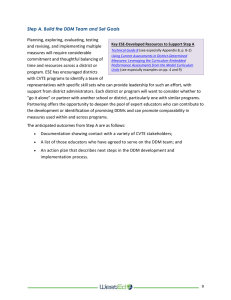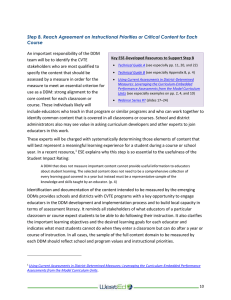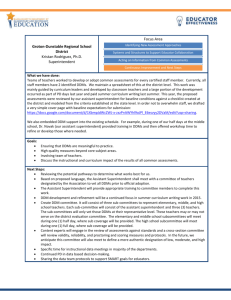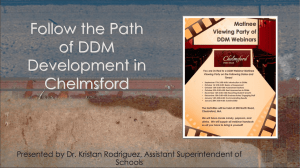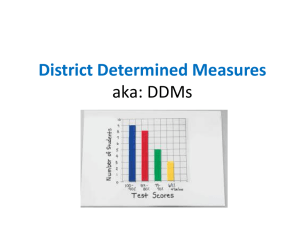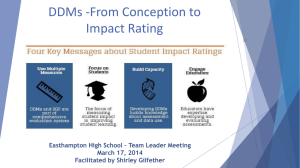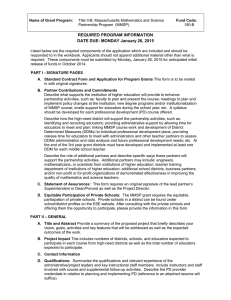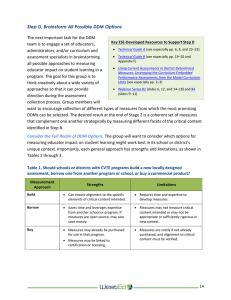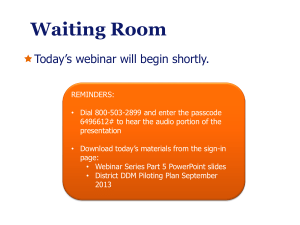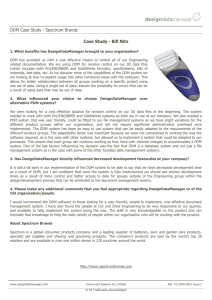DDM Resources for CVTE: Step I
advertisement
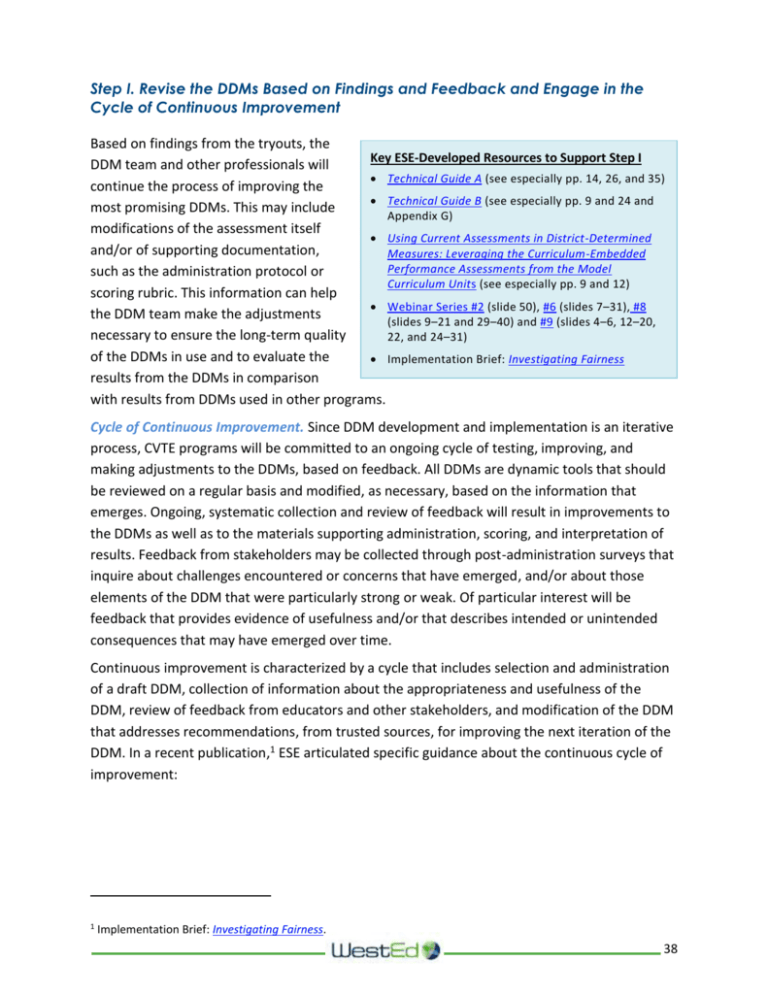
Step I. Revise the DDMs Based on Findings and Feedback and Engage in the Cycle of Continuous Improvement Based on findings from the tryouts, the Key ESE-Developed Resources to Support Step I DDM team and other professionals will Technical Guide A (see especially pp. 14, 26, and 35) continue the process of improving the Technical Guide B (see especially pp. 9 and 24 and most promising DDMs. This may include Appendix G) modifications of the assessment itself Using Current Assessments in District-Determined and/or of supporting documentation, Measures: Leveraging the Curriculum-Embedded Performance Assessments from the Model such as the administration protocol or Curriculum Units (see especially pp. 9 and 12) scoring rubric. This information can help Webinar Series #2 (slide 50), #6 (slides 7–31), #8 the DDM team make the adjustments (slides 9–21 and 29–40) and #9 (slides 4–6, 12–20, necessary to ensure the long-term quality 22, and 24–31) of the DDMs in use and to evaluate the Implementation Brief: Investigating Fairness results from the DDMs in comparison with results from DDMs used in other programs. Cycle of Continuous Improvement. Since DDM development and implementation is an iterative process, CVTE programs will be committed to an ongoing cycle of testing, improving, and making adjustments to the DDMs, based on feedback. All DDMs are dynamic tools that should be reviewed on a regular basis and modified, as necessary, based on the information that emerges. Ongoing, systematic collection and review of feedback will result in improvements to the DDMs as well as to the materials supporting administration, scoring, and interpretation of results. Feedback from stakeholders may be collected through post-administration surveys that inquire about challenges encountered or concerns that have emerged, and/or about those elements of the DDM that were particularly strong or weak. Of particular interest will be feedback that provides evidence of usefulness and/or that describes intended or unintended consequences that may have emerged over time. Continuous improvement is characterized by a cycle that includes selection and administration of a draft DDM, collection of information about the appropriateness and usefulness of the DDM, review of feedback from educators and other stakeholders, and modification of the DDM that addresses recommendations, from trusted sources, for improving the next iteration of the DDM. In a recent publication,1 ESE articulated specific guidance about the continuous cycle of improvement: 1 Implementation Brief: Investigating Fairness. 38 Districts should plan for the continuous improvement of DDMs over time. Part of this continuous improvement work will be focused on making improvements to DDMs that initial data suggest may produce significant systematic error. Sometimes, educators can make small modifications to the assessment that will go a long way toward reducing systematic error. For example, say a district uses one of the strategies described above to investigate fairness and finds that an assessment does not provide lower performing students an opportunity to demonstrate growth at the same rates as their higher performing peers [. . .] The educators working with the DDM might try adding additional easy questions to both the pre-test/post-test assessments, which will provide lower performing students opportunities to answer more questions correctly. As a result these students will be more likely to demonstrate growth at similar rates as other students [. . .] Systematic error may also be reduced by removing problematic questions. For example, if a question contains an unnecessary word that disadvantages one cultural group, this question should be edited. Analyzing student responses on a question-by-question level may help reveal problematic questions that can be modified or discarded. (pp. 6–7) Existing ESE resources provide targeted guidance to help DDM teams and other stakeholders monitor the quality of their measures on an ongoing basis and make adjustments to support claims that an assessment is fair and results are useful for the purpose intended. These resources include tips, strategies, and recommendations for (a) monitoring sources of measurement error and minimizing potential sources of bias; (b) ensuring ongoing alignment to critical content at the level of rigor intended; (c) examining comparability of measures across programs; (d) determining what can reasonably be expected as one year’s growth; (e) evaluating the appropriateness of parameters set for low, moderate, and high growth; and (f) promoting responsible professional practices around data use. The anticipated outcomes from Step I are a recommended set of local measures, for possible use as DDMs, which have been revised using feedback from small‐scale tryouts. Additionally, the ongoing collection of feedback and data, through post‐administration surveys of stakeholders, should be used to help inform continuous improvement plans and activities. 39 Lessons from the Field: Ongoing DDM Improvement Dr. Mike Ananis, Executive Director Rindge School of Technical Arts Dr. Ananis’s team has made a number of modifications to the proposed DDM instrument, based on the findings from small-scale tryouts. One finding is that the CVTE educators on the team learned that they need to be more standardized in communicating the instructions for administering their assessments. To this end, they are now improving the assessment package in terms of supporting documentation, i.e., specific guidelines for test administration. For example, for the Early Education & Care program, the educators used a repeated measure to assess clinical observation skills. Each student completed five observations over five months, and the educators used one quantitative metric and four qualitative metrics to assess each student’s clinical observation skills. They were able to demonstrate an improvement in students’ observational skills and to show growth with concrete evidence during the five-month assessment period. The educators realized that the administration of the assessment was very important for this type of performancebased assessment and was not detailed sufficiently. The educators then developed an administration protocol to guide the students throughout the length of their observations, to ensure consistency and comparability across each observation. This proved to be a very useful repeated measure that provided evidence of growth. 40 Lessons from the Field: Ongoing DDM Improvement Marcia Kessler, Technology Integration/Data Specialist Old Colony Regional Vocational Technical High School Old Colony has experienced success in collecting, reviewing, and reporting on data from CVTE assessments with educators to learn and modify both curricula and assessments. Ms. Kessler has developed insight into the development of trust among educators and administrators who are working together to critically review test results. The school is proud to have fostered the development of an environment in which educators feel they can approach their director or DDM coordinator to ask for instructional support without negative consequences. Establishing this environment strongly positions the school to develop and implement DDMs with CVTE educators effectively. For example, educators regularly review commonly used ELA assessments. During a recent review, staff noticed that students were scoring low on the ability to interpret the meaning of a word from the context, even though their educators explicitly taught them the meaning of the words on which they were tested via discrete vocabulary quizzes. They realized that students needed additional practice with contextual-analysis skills for interpreting meaning. Thus, they decided to revise the curriculum accordingly to specifically address these skills using a variety of literature and primarysource documents (e.g., famous speeches). They will continue this process of using assessment results to improve the assessments as well as to improve teaching practices. 41
